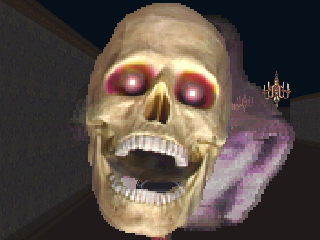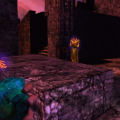When the 3DO first hit in 1993, it was a system that, despite its high price tag, seemed full of promise. It offered far more power than what systems like the Genesis could offer, while having the advantage of FMV over the Atari Jaguar. Of course, nowadays we all know just how the whole system panned out, but if there’s anyone who believed in the 3DO, it was Electronic Arts. As one of the biggest supporters of the console, they’d release a wide variety of games, some of which would become exclusives, others migrating to other systems sometime later. Among updates of games like Road Rash and Madden was this game, which, to be truthfully honest, was never all that likely to survive to the PlayStation and Saturn like certain other 3DO games.
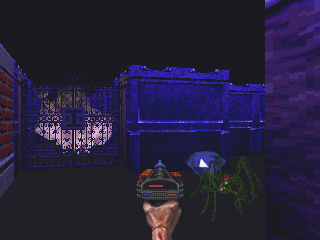
If there’s one thing this game can be credited for, it’s being the one of the first FPS games to be released on any console, at least as we know them today. Technically, while Faceball 2000 hit the SNES first, this was the first game to follow the FPS formula set by games like Wolfenstein 3D, so the game definitely deserves credit for that.
The story, as simple as it is, involved a magical talisman that protected its bearers from evil. The talisman got split up, and its pieces hidden somewhere in a haunted mansion. You, as some nameless, featureless guy with a lightning gun, have to venture into the mansion, vanquish an army of monsters, and find the pieces of the talisman. Given how early it is in the genre, a simple plot is forgivable. It would be nice, however, to have at least some kind of antagonist. The closest you get is the game’s narrator, who appears in the intro cutscene and between levels, and all he does is make Crypt Keeper-esque puns and make vague threats towards you.
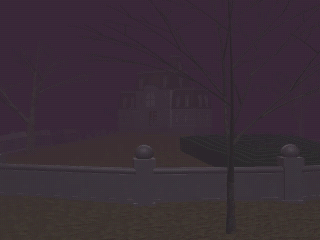
At first glance, Escape from Monster Manor might bring comparisons to Wolfenstein 3D, mostly since they generally share the same basic features. You won’t find any outdoor areas or multiple height levels, for one thing, which places the game pretty firmly in the pre-Doom era. The problem is, however, Escape is so simplistic as a shooter that there’s pretty much absolutely no content to be found past the first handful of levels. The entire game just rests on the absolute bare essentials of what makes a first person shooter, and never really goes beyond those, meaning the game gets old rather quickly. While there’s nothing technically wrong with it that would bring it to the same level as, say, Cyberdillo, the game’s spooky theme promises a lot more interest than anything else it can actually muster.
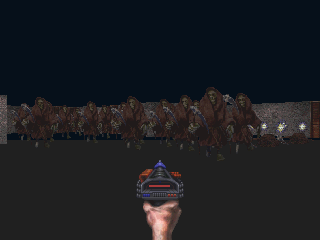
In each level, your goal is to find a piece of the missing talisman, and then to find the level’s exit. Besides the enemies, the only real obstacle you’ll have to put into navigating the levels are finding keys for the several dozen locked doors you’ll encounter. Unlike Wolfenstein, keys work on any door, but will disappear from your inventory after one use. This means that if you end up missing a key somewhere, you’ll have to scour every inch of the level to find a single key, and then hope the next locked door you open will have another. Key hunting in Wolfenstein was a bit of a pain, sure, but you only had to do it about a couple of times per level. Monster Manor, however, will often have at least a couple of dozen keys, although you usually never need every single one to clear a stage. It’s also entirely possible to unlock more doors than you can find keys, forcing you to either lose a life or reload your save from the start of the level.
Not that there’s much point in actually exploring the levels. Going off the beaten path will let you find health and ammo pickups, but if you can reach the exit with the talisman piece, you’ll start the next level with a full recharge anyway, making going back to get more pointless. You’ll also find point items, picking up enough of which will earn you extra lives. Considering the game lets you save at the start of every level, and dying resets the progress you’ve made in a level anyway, lives are functionally worthless. What this basically means that exploring the level beyond grabbing keys, health, ammo, and the talisman piece is generally a waste of time. If you do make that effort, the game is at least kind enough to give you an automap to make sure you’ve searched every corner.
You won’t find any extra weapons, because the lightning gun you begin the game with is the only gun you’ll ever have. Firing it with the A button lets loose a lightning bolt towards whatever you’re aiming at. Most enemies will only take one or two hits to kill, although every level has at least one “boss” palette swap that’ll take a multitude of shots to kill. Unfortunately, you only get 20 shots with your gun, with every ammo pickup restoring four of them. While ammo pickups are usually incredibly common, running out means you’re left entirely defenseless. The problem with having only one kind of weapon, and thus, only one type of ammo, is that if you’re full up, means there’s no point in trying to search for anything better.
The monsters you shoot at thankfully have a lot more visual variety to them, even if none of them are particularly interesting to fight. Unfortunately, there’s only four types of enemies in the entire game, two of which are mostly identical. Ghosts and scythe-wielding skeletons shuffle towards you incredibly slowly, meaning that practically the only way to get hit by them is to either get trapped in a corner with them or have them sneak up behind you. Given that so many of the levels have tight hallways, and that enemies never make a single sound besides their death sound, however, this is a lot more likely than you’d think. Monster heads float slowly towards you and shoot a stream of projectiles that can easily kill you if you have no room to strafe away from them, which makes them easily the largest threat in the game. Spiders, however, can only be killed when they leap upwards, giving you about a half second’s opportunity to kill them, which means you’re going to end up wasting a lot of ammo just trying to kill a couple.
Unfortunately, that’s about all the game offers, for the entire thirteen stages it lasts. The wall textures change up every couple of levels, but that’s about as much variety as the game ever brings forth. It does, at the least, offer cheesy horror atmosphere in spades. There’s plenty of spooky jumpscares, like turning a corner to find a hanging corpse, or ghosts that show up right in your face just to be jerks. There’s also a particularly cool touch where damage you take is reflected on your character’s decaying hand, while your ammo is clearly shown on the gun you’re wielding. It’s a nice touch that makes the game a little more immersive, although you’ll still want to check your stats pretty often by using the C button.
The one biggest issue with the graphics is that the lack of any sort of floor or ceiling textures, while it keeps the game’s frame rate steady, makes you feel like you’re traversing nothing but a black void. At the very least, Wolfenstein made the floors and ceilings gray, which made it look like you were inside an actual building. The music tends to be on the more ambient side, although it loops so often that you’ll soon be sick of the ghostly wails and constant screams that constantly play over the music. At the very least, the game’s narrator is clearly having a good time hamming it up, and hearing his speeches at the end of every level gives just a bit more motivation to push onwards.
Overall, Escape From Monster Manor is like the gaming equivalent of one of those spooky music CDs you buy from party stores. Fun for a little while, sure, and maybe even a little atmospheric, but you’ll probably be sick of it by the time you’ve went through it once. As the original first person shooter as we now know them on consoles, it deserves a certain amount of leeway for its lack of features. That doesn’t, however, mean it’s a particularly great game. Some of the same team would eventually release Killing Time for the 3DO, another horror-themed FPS that, while far from a classic of the genre, ended up being a far more enjoyable game overall.
Instead of playing the game, it’s far more recommended to check out this Let’s Play, in which the game’s lead developer and another former member of the 3DO Company play through the entire game, discussing its development, as well as their employment at the 3DO Company itself. It’s some pretty interesting stuff, and far more interesting than trying to play the game on your own.

